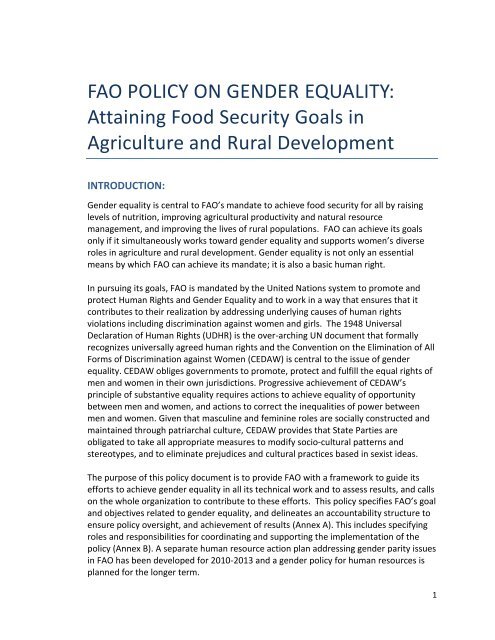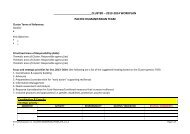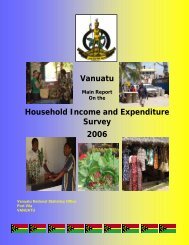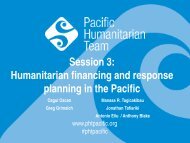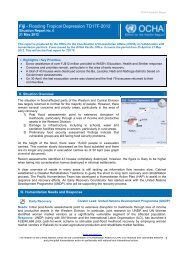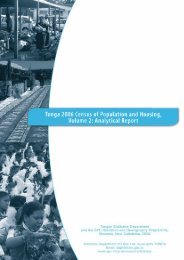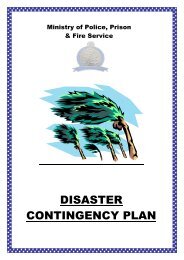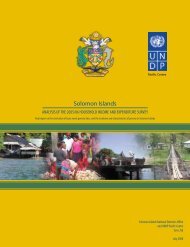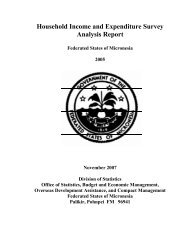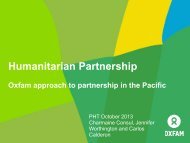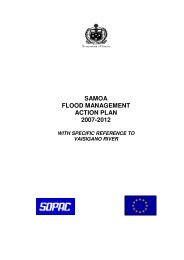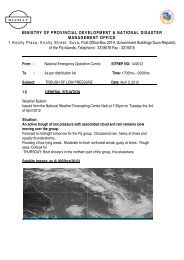FAO Gender Policy – Annotated Outline
FAO Gender Policy – Annotated Outline
FAO Gender Policy – Annotated Outline
Create successful ePaper yourself
Turn your PDF publications into a flip-book with our unique Google optimized e-Paper software.
<strong>FAO</strong> POLICY ON GENDER EQUALITY:Attaining Food Security Goals inAgriculture and Rural DevelopmentINTRODUCTION:<strong>Gender</strong> equality is central to <strong>FAO</strong>’s mandate to achieve food security for all by raisinglevels of nutrition, improving agricultural productivity and natural resourcemanagement, and improving the lives of rural populations. <strong>FAO</strong> can achieve its goalsonly if it simultaneously works toward gender equality and supports women’s diverseroles in agriculture and rural development. <strong>Gender</strong> equality is not only an essentialmeans by which <strong>FAO</strong> can achieve its mandate; it is also a basic human right.In pursuing its goals, <strong>FAO</strong> is mandated by the United Nations system to promote andprotect Human Rights and <strong>Gender</strong> Equality and to work in a way that ensures that itcontributes to their realization by addressing underlying causes of human rightsviolations including discrimination against women and girls. The 1948 UniversalDeclaration of Human Rights (UDHR) is the over-arching UN document that formallyrecognizes universally agreed human rights and the Convention on the Elimination of AllForms of Discrimination against Women (CEDAW) is central to the issue of genderequality. CEDAW obliges governments to promote, protect and fulfill the equal rights ofmen and women in their own jurisdictions. Progressive achievement of CEDAW’sprinciple of substantive equality requires actions to achieve equality of opportunitybetween men and women, and actions to correct the inequalities of power betweenmen and women. Given that masculine and feminine roles are socially constructed andmaintained through patriarchal culture, CEDAW provides that State Parties areobligated to take all appropriate measures to modify socio-cultural patterns andstereotypes, and to eliminate prejudices and cultural practices based in sexist ideas.The purpose of this policy document is to provide <strong>FAO</strong> with a framework to guide itsefforts to achieve gender equality in all its technical work and to assess results, and callson the whole organization to contribute to these efforts. This policy specifies <strong>FAO</strong>’s goaland objectives related to gender equality, and delineates an accountability structure toensure policy oversight, and achievement of results (Annex A). This includes specifyingroles and responsibilities for coordinating and supporting the implementation of thepolicy (Annex B). A separate human resource action plan addressing gender parity issuesin <strong>FAO</strong> has been developed for 2010-2013 and a gender policy for human resources isplanned for the longer term.1
This policy document also responds to the performance and reporting standards for UNentities required by the UN System-Wide Action Plan (SWAP) on <strong>Gender</strong> Equality andthe Empowerment of Women which was endorsed by the Chief Executives Board forCoordination (CEB) in October 2006, as a means of accelerating gender equality andwomen’s empowerment within the policies and programs of the UN system, andimplementing the ECOSOC agreed conclusions 1997/2 1 . The SWAP frameworkestablishes a common understanding of, and some standard requirements for, genderequality and women’s empowerment. It is intended to promote both accountability andleadership by providing senior managers with clear guidelines as to what they areaccountable for and for ensuring adequate resources and capacity in their entities to besuccessful leaders on gender equality and women’s empowerment.RATIONALECurrent data indicate that about 45% of the world’s population depends on agriculture,forestry, fishing or hunting for their livelihoods and that worldwide, women constitute43 per cent of the agricultural labor force producing a large portion of the world’s foodcrops 2 . Women’s roles range from cultivators on their own or others plots, as unpaid orpaid workers, employers and employees, and as wage-laborers in both on- and off-farmenterprises alongside their parental and child rearing roles and responsibilities.Everywhere in the world, women face constraints that limit their capacity to contributeto agricultural production and in taking advantage of new opportunities arising fromchanges shaping the rural economy. They face overt and implicit discrimination in accessto key productive resources such as land and services such as credit and extension; theyface wage discrimination in rural labor markets; they are also more likely to be in parttime,seasonal and/or low-paying jobs when engaged in rural wage employment; andthey often work without remuneration on family farms.This disproportional disadvantage or “gender gap” exists for many productive assets,inputs and services including land, livestock, labor, education, extension and financialservices. It reduces women’s productivity and diminishes their contributions to theagriculture sector, and not only affects their wellbeing and that of their families,especially in terms of their food and nutrition security, but also imposes a high cost onthe economy through productivity losses 3 . As demonstrated in the <strong>FAO</strong> flagshippublication, the State of Food and Agriculture 2010-2011 on women in agriculture,1 CEB/2006/2: United Nations system-wide policy on gender equality and the empowerment ofwomen: focusing on results and impact.http://www.un.org/womenwatch/ianwge/gm/UN_system_wide_P_S_CEB_Statement_2006.pdfSee Annex 1 for the policy2 <strong>FAO</strong>STAT, 2006 & State of Food and Agriculture, Women & Agriculture -Closing the <strong>Gender</strong> Gap forDevelopment, 20113 <strong>FAO</strong>: State of Food and Agriculture, Women & Agriculture -Closing the <strong>Gender</strong> Gap forDevelopment, 20112
closing the gender gap in agriculture would produce significant gains for society byincreasing agricultural productivity, reducing poverty and hunger and promotingeconomic growth. Enabling women to access productive resources to the same extentas men would increase yields on their farms by 20<strong>–</strong>30 percent. This could raise totalagricultural output in developing countries by 2.5<strong>–</strong>4 percent, which could in turn reducethe number of hungry people in the world by 12<strong>–</strong>17 percent. In recent years, thecombined food, climate and financial crises have led to a renewed attention to the roleswomen play in producing food and in agricultural production. <strong>FAO</strong> estimates thatworldwide about 925 million people are undernourished, with women accounting for ahigh proportion of the chronically hungry. Closing this gender gap in agriculture alonecould lift 100<strong>–</strong>150 million people out of hunger.<strong>FAO</strong> believes that increased attention is needed to reducing the gender gap across allareas of its work. At the same time, <strong>FAO</strong> recognizes that agricultural production reliesheavily on the interdependence, complementarity and partnership between women andmen in the family. It is therefore important to emphasize that reducing the gender gapis done in a way that pays attention to and advances this complementarity andpartnership. <strong>FAO</strong> believes that progress toward gender equality requires consistent andincreased institutional investment in gender expertise within the organization as well asstrengthened mechanisms and processes to ensure concrete results.In order to achieve its mandate, <strong>FAO</strong> will integrate gender issues in all facets of its work.It will ensure that gender mainstreaming becomes standard practice in its all normativework and regional, sub-regional and country level programs and projects. This action isin line with intergovernmental mandates on gender mainstreaming requiring to ensurethat all its information sharing and knowledge management activities, work ondeveloping normative public goods, policies, regional, sub-regional and countryprograms and projects, and technical interventions include a gender mainstreamingapproach by incorporating gender analysis, using sex disaggregated data, and payingattention to gender- differentiated impacts. This will contribute to increasing thecoverage, effectiveness, efficiency and ultimately the impact of <strong>FAO</strong> interventions forwomen and men, while at the same time contributing to achievement of the broaderUN goal of human rights and social justice.3
<strong>FAO</strong>’s <strong>Gender</strong> Equality Goals and Objectives:Clear synergies exist between <strong>FAO</strong>’s mandate and its gender equality goals andobjectives. <strong>FAO</strong> believes that progress toward eliminating hunger and poverty will resultfrom: (i) ensuring that its programs and projects as well as normative work reduce thegap between rural women and men in access to productive resources and services; (ii)ensuring that women and men have the ability to influence program and policy decisionmaking and build institutional responsiveness and accountability (voice); and (iii)ensuring that rural women and men can take up economic opportunities to improvetheir individual and household wellbeing (agency). Women’s ability to articulate theirneeds and priorities will facilitate the ability of rural institutions in member countries toaddress their needs and become more accountable to both women and men farmers.Similarly, both women and men need an enabling environment to exercise choices andtransform them into desired actions and outcomes.<strong>FAO</strong>’s <strong>Gender</strong> Equality GoalThe goal of <strong>FAO</strong>’s gender equality policy is to achieve equality between women andmen in sustainable agricultural production and rural development for the eliminationof hunger and poverty.This means that <strong>FAO</strong> will work toward gender equality in all its areas of work <strong>–</strong> food andnutrition security, agriculture and consumer protection, economic and socialdevelopment, fisheries and aquaculture, forestry, natural resource management andenvironment, and technical cooperation, knowledge exchange, research and extension.<strong>FAO</strong>’s <strong>Gender</strong> Equality Objectives 4The following objectives will guide <strong>FAO</strong>s work in advancing women’s and men’s equalvoice, agency and access to resources and services. <strong>FAO</strong> will work with countries, otherUN agencies, and bilateral, CSO and private sector partners to make progress asspecified below toward achieving these objectives by 2025.1. Women participate equally with men as decision-makers in rural institutionsand in shaping laws, policies and programs.2. Women and men have equal access to and control over decent employmentand income, land and other productive resources3. Women and men have equal access to goods and services for agriculturaldevelopment and to markets4. Women’s work burden is reduced by 20% through improved technologies,services and infrastructure4 <strong>FAO</strong> will develop benchmarks and time-bound targets for its work toward achievement of all its<strong>Gender</strong> Equality Objectives4
5. Percentage of agricultural aid committed to women/gender-equality relatedprojects is increased to 30% of total agricultural aid 5The major responsibility for achieving <strong>FAO</strong>’s gender equality goal and objectives lieswith its member countries. <strong>FAO</strong> is one of many agencies and actors contributing to theachievement of those goals and objectives, and <strong>FAO</strong> is accountable for the quality,efficiency and timeliness of its contribution at the output level; for monitoring theintermediate outcomes in terms of utility and effectiveness; and for monitoring, alongwith its partners, progress toward the achievement of its gender equality goal andobjectives.<strong>FAO</strong>’s major contributions toward achievement of its gender equality goal andobjectives will come from:Generating and communicating the evidence base through the use of genderdisaggregated data to substantiate the importance of closing the gender gapfor achieving <strong>FAO</strong>’s overall mandateDeveloping and sharing gender equality norms and standards for agriculturalpolicies and programsBuilding and disseminating knowledge on rural women’s needs and prioritiesin all <strong>FAO</strong>’s areas of workEnsuring the incorporation of gender analysis in the formulation,implementation and evaluation of all field programs and projectsSharing comparative data on how effectively countries are closing the gendergap in different technical areas of agriculture and rural developmentEnsuring that rural women’s needs and priorities are documented, heardand addressed in all processes that <strong>FAO</strong> leads and supports;Ensuring that none of its efforts perpetuate gender inequality or worsendiscrimination against womenWorking with partners to learn how <strong>FAO</strong>’s support for gender equality inagriculture can be more effectiveDeveloping internal structures and systems that promote gender equalityand ensuring equal participation of men and women in decision making in<strong>FAO</strong>5 In mid-2000, about 5.1 per cent of total official development assistance to agriculture wascommitted to women/gender-related agricultural projects (Ransom, E and Bain, C. “<strong>Gender</strong>ingAgricultural Aid” in GENDER & SOCIETY, Vol. 25 No. 1, February 2011 48-74).The levels of ODA toagriculture decreased from the late 1980s to mid-2000s, but have increased in more recentyears, reaching about 6 billion USD in 2008. Government expenditure on agriculture increasedfrom 55 billion USD in 1980 to 205 billion USD in 2007 (mostly attributable by spending in Asia -excluding South Asia- and in China in particular). In Sub-Saharan Africa spending on agriculturehas decreased substantially from the 1980s (Lowder, S and Carisma, B. “Financial resource flowsto agriculture” ESA Working paper No. 11-19, <strong>FAO</strong>, December 2011).5
<strong>FAO</strong>’s <strong>Gender</strong> Equality Strategy:<strong>FAO</strong> will work in two main ways to achieve its gender equality objectives. First, it willadopt gender mainstreaming internally in all its work. This means that all <strong>FAO</strong> work willsystematically examine and address women's as well as men’s needs, priorities andexperiences as part of the development of policies, normative standards, programs,projects and knowledge building activities so that women and men benefit equally andinequality is not perpetuated. Second, <strong>FAO</strong> will carry out programs and projectsspecifically targeted to women in cases where the gender equality gap is so large thatwomen cannot access opportunities that are available.As part of its gender equality strategy, <strong>FAO</strong> will implement a set of minimum standardsby 2015 to ensure the inclusion of gender mainstreaming in all its work and for targetedinterventions. <strong>FAO</strong> will also institute a series of institutional mechanisms and processesto ensure the implementation of these minimum standards.<strong>Gender</strong> Mainstreaming Minimum Standards:To ensure that <strong>FAO</strong> systematically addresses the gender equality dimensions relevant toits normative work and country-level programs and projects, <strong>FAO</strong> will put in place thefollowing standards for gender mainstreaming by 2015:That all major <strong>FAO</strong> statistical data bases incorporate sex-disaggregated data,where relevant and as available; in the short-run, this includes mining availabledata sources, notably household surveys, for gender-disaggregated statistics. Inthe long-run, separate efforts are to be made to collect and disseminate genderdisaggregateddataThat <strong>FAO</strong> invest in strengthening the capacity of member countries to develop,analyze and use sex-disaggregated data in policy analysis and program andproject planning and evaluation. In particular, technical support to datacollection activities in countries such as agricultural censuses and surveys, willpromote the mainstreaming of gender issues as indicated in the Global Strategyto Improve Agricultural and Rural Statistics endorsed by the United NationsStatistical Commission in 2010That a gender analysis is carried out and a gender action plan is developed for allstrategic objectives and progress on gender equality is measured for allcorporate outcomesThat a financial target for resource allocation for the <strong>FAO</strong> gender equality policyis set and metThat a country gender assessment is undertaken as part of the Country ProgramFramework preparation (this includes all field programs and emergency projects)6
That a gender equality stock-taking exercise is conducted for all services toprovide a basis for better implementation of gender mainstreaming includingmeasuring progress and performanceThat gender analysis is incorporated in the formulation of all field programs andprojects and gender-related issues are taken into account in project approvaland implementation processesThat all program reviews and evaluations fully integrate gender analysis andreport on the gender-related impact of the area they are reviewing.That a mandatory gender mainstreaming capacity development program isdeveloped and implemented for all professional staff and managers. Thisprogram will be tailored to the specific needs of different units in <strong>FAO</strong> HQ,regional and country levels and conducted by trainers with the subject matterexpertise relevant to those units.That minimum gender analytical competencies are specified and all managersand professional staff are required to meet themThat each technical department establishes a gender equality screening processfor all normative work, programs, and knowledge productsThat an assessment of contribution to the achievement of <strong>FAO</strong>’s gender equalityobjectives is included in the Performance Evaluation and Management Systems(PEMS) of all professional staffThat human and financial resources and normative and operational resultsrelated to gender equality from HQs to country level are systematically trackedand reported to <strong>FAO</strong> governing bodies and to the UN systemWomen-specific targeted Interventions Minimum Standards 6<strong>FAO</strong> will ensure, at a minimum, by 2017 that:30% of <strong>FAO</strong>s operational work and budget at the country and regional levels isallocated to women-specific targeted interventions. Priority attention will begiven to supporting organizations and activities that advance women’s access tonutritious food, women’s access to and control over land and other productiveresources, strengthening rural women’s organizations and networks, increasingwomen’s participation and leadership in rural institutions, incorporatingwomen’s knowledge of agriculture into programs and projects, and ensuring thedevelopment of technologies and services that reduce women’s work burden.6 OED’s Evaluation of <strong>FAO</strong>’s role and work related to <strong>Gender</strong> and Development (June 2011) showedthat only 13% of <strong>FAO</strong>’s total field program resources over the period 2002-2010 paid attention towomen’s needs or incorporated a gender perspective and that gender and development projectscomprised only 9% of TCP’s total portfolio. Since 2002, ESW led and managed work on genderrelated issues received 1% of the organization’s net appropriation.7
TCP’s total portfolio allocated to gender<strong>–</strong>equality related programs and projectsis increased from 9 to 30%Institutional Mechanisms for Implementation and Oversight:To ensure that gender mainstreaming and women-specific targeted interventions arefully implemented, <strong>FAO</strong> will institute the following institutional mechanisms andprocesses by 2015 7 .Capacity Development:o All capacity development activities integrate gender issues as relevanto The results of gender equality capacity development activities from HQsto country level are tracked annuallyo All <strong>Gender</strong> Focal Points (GFP) and alternates are appointed from HQs tocountry level are senior staff; they have written terms of reference andat least 20 per cent of their time is allocated to GFP functions andtracked in the PEMS system. Special funds are allocated to support GFPnetworking.o <strong>FAO</strong> is staffed with the appropriate mix of gender expertise and skill tocarry out its advocacy, knowledge building and sharing, technicalassistance, networking, and monitoring roles in relation to <strong>FAO</strong>’s <strong>Gender</strong>Equality <strong>Policy</strong>o All management and leadership capacity building opportunitiespromote gender equality issuesKnowledge Building:o Knowledge on gender equality, especially <strong>FAO</strong> gender equality results, issystematically documented and publicly sharedo Learning platforms and the sharing of best practice on gender equalityprogramming are supported through exchange programmes and trainingfor both male and female <strong>FAO</strong> staffCommunication:o An advocacy and awareness raising strategy on gender equality isdeveloped and implementedo A communication strategy including gender equality is developed as anintegral component of public information disseminationo All <strong>FAO</strong> public imaging and branding is gender-sensitivePartnerships:7 These mechanisms and processes accord with the UN System-wide Action Plan (SWAP) forImplementation of the United Nations system-wide policy on gender equality and theempowerment of women referenced above8
o Partnerships are developed with gender experts, CSOs especially ruralwomen’s organizations and networks, local authorities and privatesector stakeholders at country and regional levels for advocacy,technical advice, capacity development, monitoring and evaluationo Partnerships are strengthened with UN agencies especially UN Womento ensure learning and exchange, coordination and cooperation for theachievement of <strong>FAO</strong>’s gender equality objectivesCulture Change:o Processes and mechanisms are developed to minimize genderdiscrimination in the workplace and promote a gender friendly workenvironment.Monitoring & Reporting:o All organizational units, regional, sub-regional and country offices reportannually on their gender equality results. Departmental heads, regional,sub-regional and country representatives provide oversight for theimplementation of the policy in their unitso <strong>FAO</strong> Conference and Regional conferences include a standing agendaitem on gender equalityEvaluation:o The evaluation function addresses the extent to which <strong>FAO</strong> addressesgender equality issues in all the processes it lead and supportsAudit:o The audit function annually assesses <strong>FAO</strong>’s capacity to meet its genderequality mandate including gender parity in staffing at HQ, Regional andcountry levelsOversight:o <strong>FAO</strong> will establish a Steering Committee which will monitor progresstoward the achievement of <strong>FAO</strong>’s gender equality goal and objectives.This Steering Committee will be comprised of representatives from across-section of the organization from DDGs and ADGs, <strong>FAO</strong>Representatives, <strong>Gender</strong> Officers in the ROs, ESW and other technicaldepartments. It will be headed by the DDG (K) and will report to the DG.The Director of ESW will act as the Secretary of this Steering Committee.The specific roles of the Steering Committee are to :• Communicate and advocate in<strong>–</strong>house to reinforce awareness ofthe importance of the gender equality in the work of <strong>FAO</strong> and itspartners.9
• Ensure that gender-related work planning is results-orientedacross <strong>FAO</strong> in accordance with the gender equality results andaccountability frameworks.• Ensure that the allocation and disbursement of fundsorganization-wide (at HQ, regional and country level) for genderequality are made and tracked on an annual basis• Establish quality standards for gender equality and holdmanagers accountable for meeting them• Ensure that divisions and decentralized offices are managingknowledge about gender equality and gender mainstreaming forcontinuous learning.• Commission an external gender audit (of <strong>FAO</strong>s technical workand mechanisms and processes to implement its gender policy)every 5 years and oversee implementation of the gender auditrecommendations10


